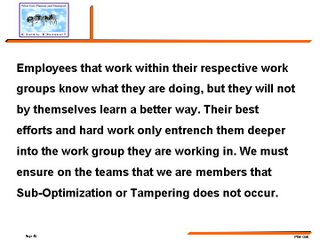There is a constant battle going on in many School Systems when it comes to Mainstreaming/Inclusion Autistic (ASD) students with a one-on-one-aide for an indefinite time period (i.e., 2-5 years) or rotate 2-3 aides every few months and replacing existing ones when new aides are hired.
It does not matter which solution is correct or a combination of solutions. What matters is the affect it will have on the child, teacher, and classmates, end of story.
I have zero tolerance for any behavior or decision that is not in the best interest of the child/student.With reference to my previous post on this subject
http://qualityg.blogspot.com/2007/09/what-is-purpose-of-mainstreaming.html I would like to explain when a change of this magnitude takes place.
When working as an aide you work within a system (Special Education) made up of sub-processes (i.e. Mainstreaming one-on-one support).
In order to understand this clearly it needs to be explained through Systems Thinking and Process Improvements.
System Thinking means:
“Employees work in a System. Management owns the System.”A system is a whole consisting of two or more parts, (1) each of which can affect the performance or properties of the whole, (2) none of which can have an independent affect on the whole, and (3) no subgroup of which can have independent affect on the whole. In short, then, a system is a whole that cannot be divided into independent parts or subgroups of parts.
When changes are implemented without regards to trending data, accurate information, documented observations, and failure to understand end-to-end thinking chaos will run through your process.
Process means:A series of steps or actions that lead to a desired result or output (what do we expect when we are done. If we don’t know the goal or outcome then anything will be right or wrong depending on the person in charge). Goals are to be created by Management not the other way around. Workers develop the means (plans, strategy, work plans, job aides & a way to measure to determine success) based on their subject matter expertise to meet the goals.
A set of common tasks (standard – if no standard you have no means for a stable process) that creates a product, service, process, or plan that will satisfy a customer or group of customers. If a permanent aide is ill or has to leave for a period of time, plans already should be in place for another existing aide who the child is comfortable with to fill in the gap. Prioritize your ASD children with you aides and it will work out fine (test & determine).
A sequential series of steps leading to a desired outcome (if you have no operational definition, purpose or goal established by management you WILL have failure).
Processes are largely affected by one or more of the following factors:
a) personnel who work in the processes (not including anyone or group that works in the process will result in failure, frustration and high turnover);
b) materials which are used as inputs (including behavioral logs, documented observations and subject matter expert information and data);
c) testing techniques being used in the process (in process execution or monitoring/measurement;
d) methods (including criteria and various documentations used along the process, how will we know if we are successful, if you don’t have methods success is determined through management who own the system);
e) work environment (if any of the above are not correct it will affect the environment big time).
Understanding how these factors interact and affect processes is a key consideration in process studies and quality improvement.
Standardization - for an explanation read my post at http://qualityg.blogspot.com/2006/07/quality-tooltechnique-standardization.htmlEvery process improvement starts and ends with standardization. Everyone (aides) doing the same process must be doing the same type of measuring, using the same methods, documenting the same log sheets (keeping them for improvement opportunities) with the same set of codes and understanding and object observations that are part of process (job). If none of these are set up or in place you have an out-of-control process with willing workers doing their best to create structured chaos. If this is the case the success or failure belongs to management because they own the process/system.
So with changing a permanent aide who has worked with an ASD child for years and has been successful based on those who have worked with the child including his personal therapist and psychiatrist can result in a traumatic result to the child.
This is especially true if the process is stopped abruptly and changed radically with little or no reliable data or information on what to improve and more importantly on how to improve the situation. Change for the sake of change is stupid!
When this type of change happens in business you can lose a customer, in education you take the chance of losing a child’s education, knowledge and involvement in society. You may get a customer back but in education the child becomes lost in the system.
If management (administrators) wishes to make changes such as these with so much at risk they should at least do the following;
Start off with documenting a standard method/procedures (with purpose & goals) by which all aides will work in the same manner.
Next begin to monitor the new method (process) with objective data, input and information from reliable sources (including parents, teachers & aides.
Most importantly conduct a test case with appropriate people, measures and child because of the risk factor (child’s learning). To not do this is instant failure.
Management will let you know when something is a failure or if something is right if you start out without knowing the AIM/Purpose of your system you are doing nothing more than tampering with the system.
When implementing changes management should listen to the Voice of the Process and People and not the other way around . – VERY DANGEROUS.
As I have often stated
“Data + Information + Application = Knowledge”
add Listening to the equation and you get Wisdom”




